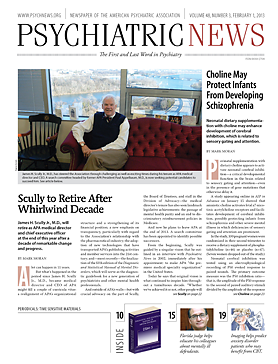Alzheimer Dementia Trials Omit Patients Without Spouses
Clinical trials involving patients with Alzheimer’s disease (AD) dementia can be particularly difficult to conduct, largely because they require the enrollment of both the patient and his or her caregiver. But can the relationship between the AD patient and the caregiver affect trial participation and outcomes?
Researchers based at the Mary Easton Center for Alzheimer’s Disease Research in the Department of Neurology at the University of California, Los Angeles, recently performed a retrospective analysis of six Alzheimer’s Disease Cooperative Study randomized clinical trials, evaluating the prevalence of study-partner type and the associations between study-partner type and trial outcomes. They found that more patients (67 percent) enrolled with spouses than with adult children (26 percent) or other caregivers (7 percent). Patients with spouse caregivers had a lower study dropout rate (25 percent) than those who had their adult children (32 percent) or other people (34 percent) as caregivers.
The researchers said their data do not explain why patients with nonspouse study partners were underrepresented. However, compared with spouses, adult-child caregivers were more likely to be working and living apart from the patient, increasing the logistical challenge to research participation. “Another possible reason is that trials typically require patients with mild severity and thus enroll young AD patients who, in turn, may be more likely to have spouses,” they noted. They concluded that increased enrollment of AD patients with nonspouse caregivers may require additional recruitment and retention strategies.
HIV-Infected Smokers Lose More Years to Smoking Than to HIV
Smoking poses a greater risk to the life expectancy of a well-treated HIV patient than does HIV disease, a Danish study has found. After evaluating data on 2,921 HIV-infected patients and 10,642 controls, researchers at Copenhagen University Hospital concluded that in a setting where HIV care is well organized, and antiretroviral therapy is free, HIV-infected smokers lose more life-years to smoking than to HIV-related diseases.
Their findings showed that excess mortality of smokers is tripled and the population-attributable risk of death associated with smoking is doubled among HIV patients, compared with the background population. “Owing to the high proportion of smokers among HIV patients, the population-attributable risk of death associated with smoking was large, which underscores the importance of prioritizing interventions for smoking cessation in the care of HIV patients, as well as in the general population,” they said.
Study subjects came from the Danish HIV Cohort Study, a population-based nationwide cohort study of all HIV-infected individuals treated at Danish HIV centers after January 1, 1995. The control population came from the Copenhagen General Population Study, a prospective study of a cohort of individuals randomly selected from greater Copenhagen.
Helleberg M, Afzal S, Kronborg G, et al. “Mortality Attributable to Smoking Among HIV-1-Infected Individuals: A Nationwide, Population-Based Cohort Study.” Clin Infect Dis. 2012. December 18
http://www.ncbi.nlm.nih.gov/pubmed/23254417.
Psychiatric Patients More Likely to Die of Cancer
Psychiatric patients are for the most part no more likely than the general population to develop cancer, but are more likely to die of it. Australian researchers recently performed a population-based record-linkage analysis that compared psychiatric patients with the general Western Australia population to determine why. Mental health records were linked with cancer registrations and death records from January 1, 1988, to December 31, 2007, in Western Australia.
Their findings were alarming. Cancer incidence was lower in psychiatric patients than in the general population in both males and females, although mortality was higher and the proportion of cancer with metastases at presentation was significantly higher in psychiatric patients. Despite this, psychiatric patients had a reduced likelihood of surgery, especially resection of colorectal, breast, and cervical cancers, and they received significantly less radiotherapy for breast, colorectal, and uterine cancers, as well as fewer chemotherapy sessions.
“These results could suggest inequitable access to appropriate care, especially given that reduced access to treatment persisted after controlling for the presence of metastases,” wrote the researchers. “The results may indicate action required to decrease inequity and thus improve health outcomes of psychiatric patients. They also pointed to the need for cancer screening and treatment for psychiatric patients similar to those that exist for cardiovascular and diabetes care for these patients.
Workplace Bullying Leads to Psychotropic Medication Use For Victims and Observers
Finnish researchers reported that people who are bullied at work, or even those who simply observed bullying taking place at work, are more likely to take psychotropic medication at some point after the bullying occurs. The researchers linked data that detailed purchases of prescribed reimbursed psychotropic medication from the Finnish Social Insurance Institution register with a survey of the employees of the city of Helsinki, Finland, who were 40 to 60 years old (n=6,606, 80 percent women). The researchers noted that the city of Helsinki is the largest employer in Finland, and there are around 200 different nonmanual and manual occupations. After adjusting for age and prior medication use among both women and men, they found that being bullied in the workplace and observing bullying in the workplace were associated with subsequent psychotropic medication use. “These findings confirm those from previous cross-sectional studies and, in particular, corroborate associations found between workplace bullying and self-reported mental health,” the researchers wrote. The study was funded by the Academy of Finland.
Lallukka T, Haukka J, Partonen T, et al. “Workplace Bullying and Subsequent Psychotropic Medication: A Cohort Study With Register Linkages.” BMJ Open. 2012. December 12 [Epub ahead of print].
http://bmjopen.bmj.com/content/2/6/e001660.full.
Some Cancer Survivors Report Poorer Mental, Physical Health
Data from the 2010 National Health Interview Survey show that cancer survivors experience poorer physical and mental health than the general population, and researchers at the Wake Forest School of Medicine say interventions are needed to improve survivor health at a population level. The researchers identified 1,822 cancer survivors and a control group of 24,804 adults with no cancer history from the survey and used the PROMIS Global Health Scale to assess health-related quality of life (HRQOL). Poor physical and mental HRQOL were reported by 24.5 percent and 10.1 percent of survivors, respectively, compared with 10.2 percent and 5.9 percent of adults without a history of cancer. “This represents a population of approximately 3.3 million and 1.4 million U.S. survivors with poor physical and mental HRQOL,” wrote the researchers. They noted that the HRQOL varied according to the type of cancer experienced: Survivors of breast or prostate cancer or melanoma reported scores similar to adults without cancer. Survivors of cervical, colorectal, hematologic, short-survival, and other cancers had worse physical HRQOL. Cervical and short-survival cancer survivors reported worse mental HRQOL. “Not all survivors report they are thriving,” wrote the researchers, who urged that easily implemented interventions be pursued for high-risk groups. ■
Weaver K, Forsythe L, Reeve B, et al. “Mental and Physical Health-Related Quality of Life Among U.S. Cancer Survivors: Population Estimates From the 2010 National Health Interview Survey.” Cancer Epidemiology Biomarkers and Prevention Online First. 2012. October 30
http://www.ncbi.nlm.nih.gov/pubmed/23112268.

